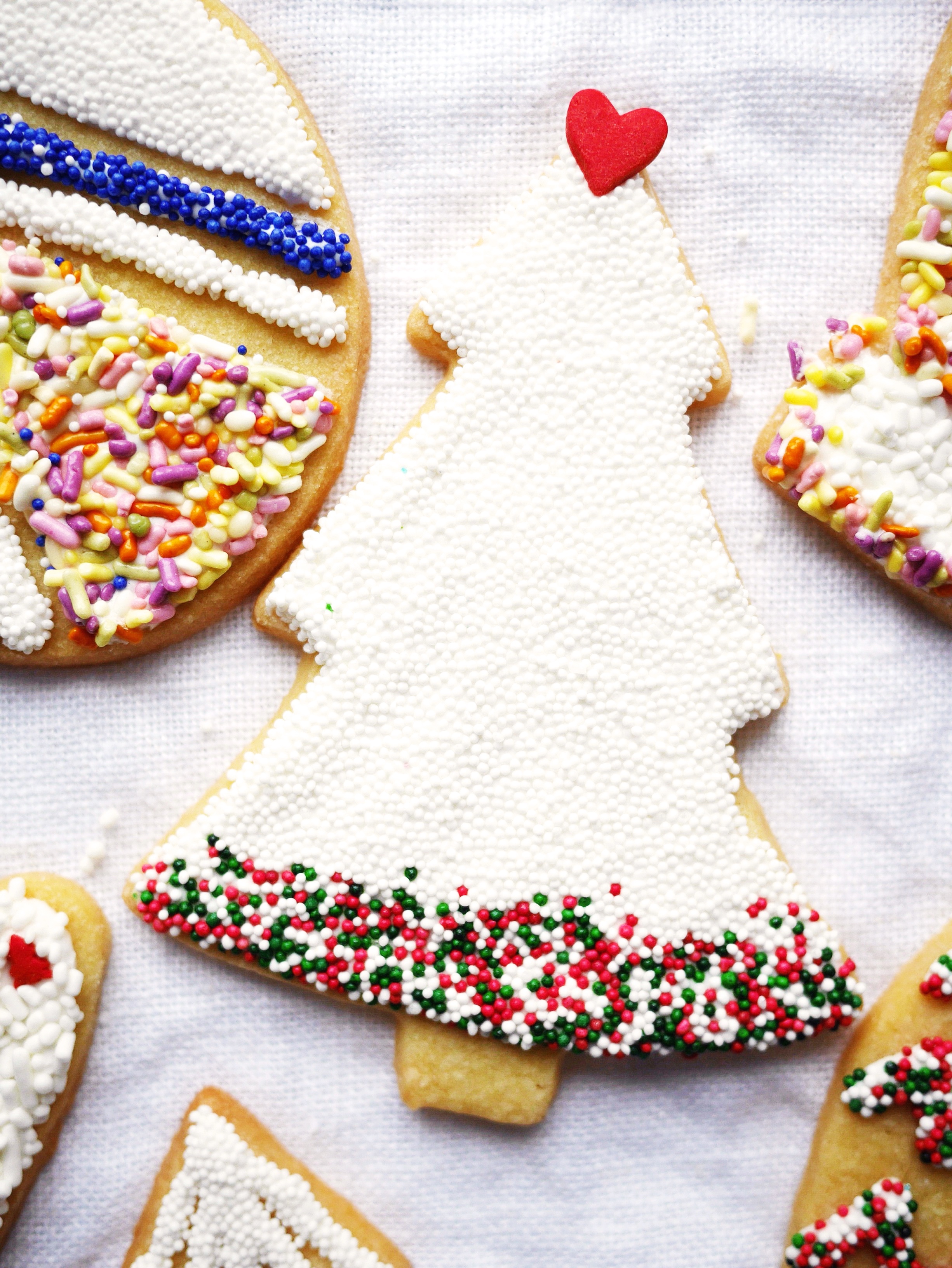Decorating sugar cookies is one of my favorite holiday activities. I love sitting down for an afternoon of icing and sprinkles. Once you have your batch of sugar cookies ready to decorate, it’s time for the fun part. Choose from three icing recipes (based on what you already have in your pantry) and set up your toolkit for cookie success. Let’s get started!
If you’re home with family for the holidays, I recommend getting everyone involved. For the past three years, my mom, sister, and I have decorated 200 cookies for our holiday party. Sitting together and chatting while we’re icing is fun catch-up time, and it’s inspiring to see the different designs we each come up with.
If you’re alone, I highly recommend queuing up a few podcasts to keep you company. I got through about ten episodes of Serial and Inquiring Minds during my recipe development for this post.
If you read my sugar cookie recipe post, you know I have a lot to say about best practices. This is another long post. I wanted to share everything I’ve learned over the past three years so you can have great success! With that in mind, I’m going to jump past storytelling and science to get right to the how-to.
About my icing recipes:
When it comes to something like the icing on a sugar cookie, taste isn’t a paramount concern. The icing is usually covered by sprinkles and/or spiked with food coloring. It’s all about ease for me. I want it to come together quickly with things I have in my pantry and I want it to be easy to pipe on the cookies.
Regarding food coloring: I like to decorate with white icing and use various sprinkles as my color. If you do want to use food coloring, choose your recipe below, then divide the final batch into separate bowls and color as desired.
Make measuring easy! A standard 1 pound box of confectioners sugar equals 3 ¾ cups. All recipes assume you are using one box. If you have a large bin in your pantry, weigh 1 pound or measure 3 ¾ packed cups.
Okay, commence the icing choose-your-own-adventure!
Here's what the consistency of your icing should look like when you lift the whisk out of the bowl. Slightly runny but not watery:
Royal Icing with Egg Whites This produces an icing with the trademark glossy sheen of a good royal icing. It’s easy to make, since you likely have 3 eggs sitting in your fridge. The concern here is using raw egg whites, which can be a health concern for some. You can solve this by buying pasteurized eggs (they exist!) or using meringue powder.
Make the icing: Combine 1 lb. (3 ¾ cups) confectioner'ssugar with 3 large eggwhites in the bowl of an electric mixer fitted with the whisk attachment (or use a handheld mixer). Whisk on medium-high until peaks form. Thin as needed with 1 teaspoons of water at a time until the icing looks glossy and bright white.
Royal Icing with Meringue Powder Meringue powder is made from powdered egg whites and is my favorite pick to make royal icing. You’ll still get the volume and body of an egg white-based royal icing, but without health concerns of raw eggs. Plus, meringue powder is inexpensive and can keep in your pantry for years. This is a great option for health safety and that classic look, but requires getting an extra ingredient from the store.
Make the icing: Combine ½ cup meringuepowder with ½ cup water in the bowl of an electric mixer fitted with the whisk attachment (or use a handheld mixer). Whisk on medium-high until peaks form. Add 1 lb. (3 ¾ cups) confectioner'ssugar and beat until well combined. The mixture should look glossy and bright white. Thin as needed with 1 teaspoon of water at a time.
Milk-based Icing (Egg-Free) Technically, a royal icing has to contain eggs, so this super simple version is just an icing. It doesn’t have the brilliant white shine of the egg-based royal but it is so easy. I recommend this version if decorating with kids or if you want to quickly decorate a batch. This recipe is good for anyone with egg-allergies or who doesn’t want to buy a special ingredient or use raw eggs.
Make the icing: Combine 1 lb. (3 ¾ cups) confectioner's sugar and ¼ cup milk in the bowl of an electric mixer fitted with the whisk attachment (or use a handheld mixer). Whisk on medium-high until the mixture is completely smooth with no lumps remaining. Add 1-2 tablespoons milk, until the mixture is easily pourable but not too runny.
When you lift whisk out of the mixture, the icing should slowly run off the end, not pour too quickly. If you have added too much milk, just add some more confectioners sugar.
Your Decorating Tool Kit
Once you have the cookies and the icing ready, a few tools make decorating easy and efficient. I have SweetDaniB, a cookie-decorating guru, to thank for teaching me about how to decorate a cookie well, and what is helpful to keep on hand (more about her in my sugar cookie post). Check her site and instagram out for inspiration.
Squeeze bottles vs. Pastry bags I use small squeeze bottles to decorate my cookies. They are reusable, easy to refill, and easy to handle. Pastry bags, particularly plastic ones, are fine to use, but I find they create extra mess. I particularly like accordion-style squeeze bottles like these from Kuhn Rikon. If you do use a squeeze bottle, I recommend keeping it inverted it in a sturdy glass or mug between piping, so the frosting is easy to squeeze out.
Surgical Tweezers For intricate designs and accurate placement, an inexpensive pair of surgical tweezers are indispensable. Amazon stocks inexpensive ones.
Offset Spatula After piping icing into your desired shape, an offset spatula allows you to smooth the icing to evenly fill the shape. I also use a clean offset spatula to gently press and jimmies into the icing to firm up an edge.
Toothpicks What can’t this kitchen workhorse do? A box of toothpicks is inexpensive and will see you through testing cakes, hors d’oeuvres, and now, cookie decorating. Use to smooth icing, as with the offset, above, to fill up a design or smooth an edge.
Paper plates Decorating on top of a paper plate allows you to save the sprinkles that don’t attach to the icing. After the sprinkles have covered the icing, move the cookie aside, fold the plate into a funnel-like shape and pour the remaining sprinkles back into the original jar. Repeat with fresh icing and sprinkles.
Rimmed baking sheets It’s a constant battle between my creative artist side and my inner neat freak when it comes to decorating cookies. I love the explosion of colors and shapes and it can be fun to let loose and see what fun designs you can create. However, nonpareils have a sneaky way of rolling amok. Decorating with all your tools inside a rimmed baking sheet keeps the mess at bay.
How to ice the cookies:
Now that you’ve read through all of the above, I hope it doesn’t seem too daunting. To ice is actually quite simple.
For a lined design: Squeeze or pipe the frosting into your desired design, pour the sprinkles on top, remove the cookie, fold the paper plate and pour the sprinkles back into the bottle, and repeat.
For a filled design: Pipe the outline of the shape. Then, pipe even zigzags of icing inside the shape to fill. Smooth with an offset spatula or toothpick, then pour sprinkles over the icing. Remove the cookie, fold the paper plate and pour the sprinkles back into the bottle, and repeat.
To create different areas of color, sprinkles, etc: Pipe the first area, decorate with sprinkles, then let dry for at least 20 minutes. If the icing is still wet at all, the other color of nonpareils will find a home in the already iced portion.
A big note for ultimate success!: Do not pipe your icing too close to the edge of the cookie. Start with a ¼-inch border until you feel more confident with your technique. Sprinkles will weigh the frosting down and push it towards the sides. If you do have frosting that runs down the sides, don’t panic. Use a toothpick or an offset spatula to scrape along the cookie, perpendicular to the edge. (I actually love this look and use it often now.)
Good luck and have fun!






